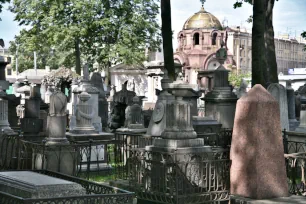One of St. Petersburg’s most visited attractions, the Alexander Nevsky Monastery complex was once home to more than a dozen Russian Orthodox churches. Many famous Russians are buried at the cemeteries of the complex.


History of the Complex
The area that has been known as the Alexander Nevsky Monastery since 1797 had its beginnings in 1710, just a few short years after the city of St. Petersburg was founded. It was located at the former site of the Swedish Fort Landskrova, a significant location during the Northern War between Russia and Sweden. Peter the Great chose to name the monastery after Grand Duke Alexander Nevsky, who defeated the Swedes in a 1240 battle at the site.
The first church, a small wooden structure, was built in 1712, but a new church, designed by Italian architect Domenico Trezzini, was added in 1724. It was this building, in particular, that was named for Nevsky, who was considered a saint in the Russian Orthodox Church. His remains were moved here from a church in Vladimir and for many decades, the day they arrived was celebrated as a holiday.
A quarter-of-a-century later, Empress Elizabeth saw to it that a silver shrine was built to house the remains. It contained a whopping one-and-a-half tons of pure silver and was decorated with scenes from Nevsky’s famous battles. By the end of the eighteenth century, the monastery was elevated to the highest rank in Orthodox hierarchy and was dubbed the Alexander Nevsky Monastery of the Holy Spirit. And by the early twentieth century, there were 16 churches on the property. However, the Russian Revolution accounted for the destruction and pillage of many of the churches and today, only five remain.
In the 1930s, all the churches were closed and a few were used for secular purposes. Holy Trinity Cathedral was finally returned to the Orthodox Church in 1955 though destruction continued throughout the Cold War.
Finally, in 1985, services began once again at the Church of St. Nicholas, and a few years later, Nevsky’s remains were returned to the cathedral from another church at the complex that had been converted into The Museum of Atheism.
Holy Trinity Cathedral
The monastery is dominated by the centrally located Holy Trinity Cathedral, built in 1790 by the renowned Russian architect Ivan Starov. The Neoclassical domed church is best known for its interior, where you’ll find a magnificent iconostasis with gilded bronze gates. Near the iconostasis is the reliquary of Alexander Nevsky. His remains were brought to the earlier built church in 1724. Alexander Nevsky is considered a Russian Saint since the sixteenth century and is also the patron saint of St. Petersburg.
Necropolis

Truly, most tourists head to the Alexander Nevsky Monastery complex to visit the Necropolis there, a group of cemeteries which boast the graves of many famous Russians. Head to the Tikhivn Cemetery for the most notable burial spots, including the graves of composers Tchaikovsky, Mussorgsky, Rimsky-Korsakov, and Glinka, as well as that of author Dostoevsky. In Lazarus Cemetery, several famous Russian architects – who may not be as well known to foreign visitors – are buried. They include Starov, Quarenghi and Rossi.

